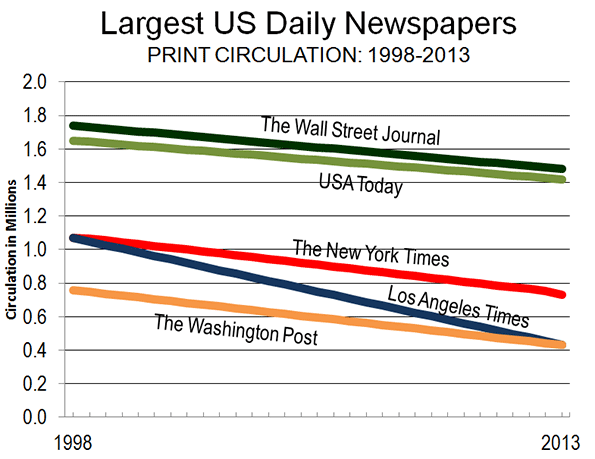
It has been a difficult time for newspapers. The industry has experienced serious challenges due to multiple factors going back at least to the early 1960s when the three major television networks began their extensive and widely popular evening news programs, with the likes of Walter Cronkite, Chet Huntley and David Brinkley.
Recent Setbacks
The rise of the Internet over the last two decades has posed a much larger challenge. More people were able to access more interactive news sources, including the Internet editions of major newspapers, nearly all of which were free in the beginning. Then there was Apple, with its ground-breaking iPad which made accessing news sources more user-friendly. Newspapers competed hard to design their own applications, which often required paid subscriptions. Of course, Ipad has competitors now and many newspapers have implemented paid firewalls for their Internet sites.
However, the Great Recession may have dealt the most important blow to the print edition. The collapse of the housing market brought a catastrophic decline in real estate and help wanted classified advertisements, a key source of revenues. Added to this was a drop in overall business, which also reduced advertising revenues.
Some large newspapers such as The Wall Street Journal,and The New York Times claim they have gained circulation. However, looking beneath the gross numbers provided by the Alliance for Audited Media, it is clear that virtually all of the gains are in on line editions, while print editions continue to decline. Even the online gains may be overstated, because a print edition subscriber who is also an online edition subscriber gets counted twice for the same newspaper.
Smaller Press Runs
A review of the change in circulation in the nation's 20 largest newspapers since 1998 indicates the depth of the losses. The year 1998 is chosen because newspaper circulations remained at high levels and the losses to Internet editions and other media sources has not yet occurred.
From 1998 to 2013, the 20 largest newspapers lost more than 5 million of their 13.4 million weekday print subscribers, a loss of nearly four out of ten subscribers (39 percent). At the same time, there were substantial differences among the top 20 papers in their losses (Table).
| Top 15 Newspapers in 1998: 1998-2013 Print Circulation | |||
| Newspaper | 1998 | 2013 | % Change |
| The Wall Street Journal | 1,740 | 1,481 | -14.9% |
| USA Today | 1,653 | 1,424 | -13.8% |
| The New York Times | 1,067 | 731 | -31.5% |
| Los Angeles Times | 1,068 | 433 | -59.5% |
| The Washington Post | 759 | 431 | -43.2% |
| New York Post | 438 | 409 | -6.6% |
| Chicago Tribune | 673 | 368 | -45.3% |
| New York Daily News | 723 | 360 | -50.1% |
| Arizona Republic | 435 | 286 | -34.3% |
| Newsday (Long Island) | 572 | 266 | -53.5% |
| Houston Chronicle | 551 | 231 | -58.0% |
| Minneapolis Star Tribune | 335 | 228 | -32.0% |
| The (Cleveland) Plain Dealer B. | 382 | 216 | -43.4% |
| The Denver Post | 342 | 214 | -37.5% |
| San Diego Union-Tribune | 378 | 194 | -48.7% |
| The Dallas Morning News | 480 | 191 | -60.3% |
| The Philadelphia Inquirer | 429 | 185 | -56.9% |
| Chicago Sun-Times | 486 | 185 | -62.0% |
| Newark Star-Ledger | 407 | 180 | -55.7% |
| The Boston Globe | 471 | 172 | -63.5% |
| Total | 13,389 | 8,185 | -38.9% |
| In thousands | |||
| Source: Alliance for Audited Media & predecessor | |||
Losers and Catastrophic Losers
All of the newspapers lost subscribers, but some lost many more than others. The New York Post, a tabloid owned by Rupert Murdoch, posted the smallest loss, less than 30,000 of its 1998 subscriber base of 438,000.
USA Today, Gannett’s unique national general-interest newspaper, experienced the second smallest loss, at 13.8 percent. USA Today, also the newest newspaper on the list (1982), is the nation's second-largest newspaper and fell from a circulation of 1.65 million in 1990 to 1.42 million in 2013.
Another Murdoch title, The Wall Street Journal, purchased in 2007, did a third-best in holding onto its print readership. The Journal retained its position as the largest daily newspaper in the nation, with circulation dropping from 1.74 million in 1998 to 1.48 million in 2013. This amounted to a small loss compared to other newspapers (14.9 percent). The 260,000 loss in actual subscribers was larger than the total current daily circulation of 10 of the top 20 US newspapers (such as the Houston Chronicleand The Boston Globe).
The nation's third largest newspaper, The New York Times, lost nearly one-third of its print circulation between 1998 and 2013. Even so, this was less than the loss rate of all but three newspapers (The New York Post, The Wall Street Journal and USA Today).
The largest relative circulation loss was atThe Boston Globe, which saw a departure of nearly two-thirds (63.5 percent) of its subscribers. This was more than double the losses by its owner, The New York Times.
Two other newspapers lost 60 percent or more of their readers between 1998 and 2013. The Chicago Sun-Times experienced a loss of 62 percent while The Dallas Morning News saw 60 percent of its subscribers flee. This huge loss is particularly notable, given that the Dallas-Fort Worth metropolitan area is one of the fastest growing regions in the world. For example, in Phoenix, which has also grown very rapidly, theArizona Republic lost only one third of its readership, having taken advantage of the rapidly expanding market.
Perhaps most disastrous has been the decline at the Los Angeles Times. For more than two decades, the LA Times had been the nation's third or fourth largest newspaper, following The Wall Street Journal, USA Today and sometimes The New York Times. This ranking was not much changed in 2013, as the LA Times was the fourth largest newspaper.
However, over 15 years, the LA Times lost nearly 6 out of every 10 of its subscribers. In 1998, the LA Times had 1,000 more subscribers than The New York Times, at 1,088,000. By 2013, print subscriptions at LA Times had fallen to 433,000. Over the period, The New York Times managed to secure a stranglehold on third position, opening a nearly 300,000 subscriber lead over the LA Times. Should the losses at the LA Times continue at this rate, it could be passed by both The Washington Post and the New York Post within a couple of years (Figure).

In raw subscriber numbers, the LA Times losses were the most precipitous by far at 635,000, compared to second largest loss at the New York Daily News at 363,000. The Daily News continues a long slide, having been the nation’s largest newspaper for decades to the 1970s. It is now the third-largest paper in the three paper New York City market, having been passed by the New York Post some time ago. The Daily News, however, still leads the suburban Newsdayand Newark Star-Ledger.
Even Bigger Losses
Some of the larger declines in newspaper circulation are not evident in the latest data. For example, The San Francisco Chronicle experienced a drop of 65 percent in its circulation from 1998 to 2012 (2013 data not available). The spectacular decline of Detroit’s two metropolitan dailies has outstripped all of the others over a longer period of time. In the middle 1980s, the Detroit Free Press and the Detroit News each had circulations of approximately 650,000. By 2012, the Free Press had fallen to approximately 135,000 and the News to under 80,000. These drops were much larger than the city of Detroit’s population loss. Now, the two papers offer home delivery only three days of the week (Thursday, Friday and Sunday), while subscribers are encouraged to use internet editions on other days.
Of course, over the last 15 years, a number of familiar titles have been closed, such as the Rocky Mountain News (Denver), the separate Atlanta Journal and Constitution (now combined as the Atlanta Journal-Constitution) and the Cincinnati Post. The Seattle Post-Intelligencer took the intermediate step of shutting down its print edition, but retaining an Internet edition, which has remained a strong presence online.
Where from Here?
There have been other changes as well. Virtually all of the US broadsheets (the wide, familiar print format) are now printed in more compact editions, having been reduced from approximately 15 inches wide to 12 or even 11 inches wide (28, 30.5 and 38 centimeters). There are international format changes, as well. The Times of London (weekday edition) converted from broadsheet to tabloid in 2004, while The Sydney Morning Herald and Melbourne’s uniquely named The Age switched to tabloid format in March.
The communications business has changed over the past two decades. Newspapers have been trying to cope, but it seems unlikely that print editions will experience any resurgence. The open question is whether the newer online strategies will save them from oblivion, but that’s hard to predict.
Wendell Cox is a Visiting Professor, Conservatoire National des Arts et Metiers, Paris and the author of “War on the Dream: How Anti-Sprawl Policy Threatens the Quality of Life.
Photo: Los Angeles Times headquarters courtesy of WikiCommons













You know your projects stand
You know your projects stand out of the herd. There is something special about them. It seems to me all of them are really brilliant!
ge
Death from many sources
Newspapers have only themselves to blame.
Craigslist - took 90% of small classifieds
eBay - took the remaining 10%
Monster.com and other jobs sites took all the help-wanted ads
Zillow and realtor.com took all the real-estate ads
Newspapers watched this happen and did nothing except hold executive planning meetings.
For some reason, car dealers and furniture retailers still advertise in print. I expect that to change as more and more people look online first and only.
Dave Barnes
+1.303.744.9024
abbott
Abbott is a global healthcare company devoted to improving life through the development of products and technologies that span the breadth of healthcare.
For US and Puerto Rico residents, if you are unable or limited in your ability to use or access Abbott Careers due to a disability, you can request reasonable ...
Abbott
Nutrition provides healthcare professionals with information on how we can partner to help patients take important steps toward healthy living and greater ...
Learn more about Abbott, the global healthcare company that conducts innovative research and manufactures products for human health through every life ...